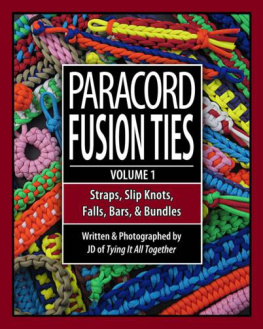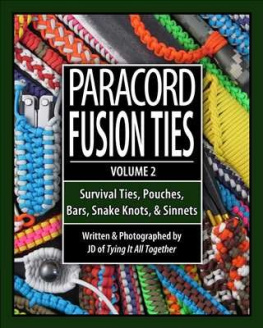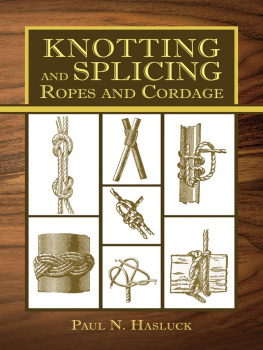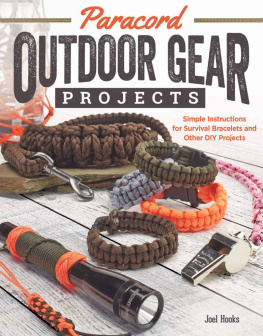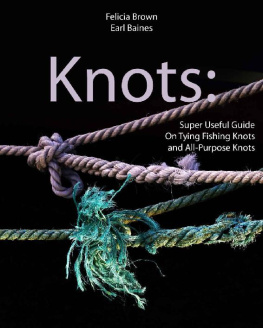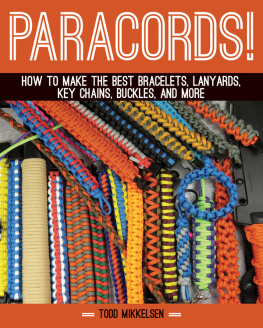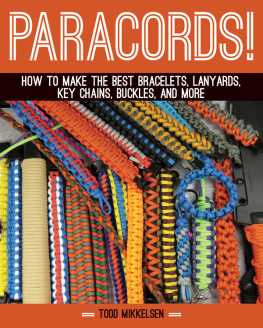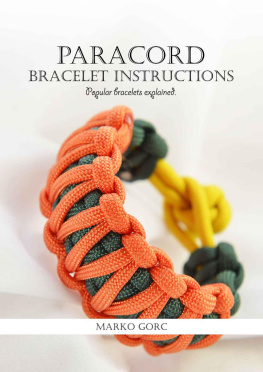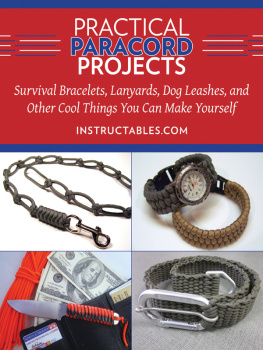Paracord Fusion Ties
Volume 1
Straps, Slip Knots,
Falls, Bars, & Bundles
Written & Photographed by
J.D. of Tying It All Together
4th Level Indie
Paracord Fusion Ties - Volume 1
by J.D. Lenzen
ISBN: 978-0-9855578-2-9
4th Level Indie
Author's site: fusionknots.com
Copyright 2012 by J.D. Lenzen. All rights reserved.
No part of this book may be reproduced, stored in a retrieval system, or transmitted by any means, without written permission from the publisher, except by a reviewer, who may quote brief passages in a review where appropriate credit is given.
Because of the dynamic nature of the Internet, any web addresses or links contained in this book may have changed since publication and may no longer be valid. Further, any and all vendor information provided in this book does not constitute an endorsement or recommendation by the publisher or the author.
Foreword
I grew up as an Army brat and spent some time in the Boy Scouts. So I'm not a complete stranger to rope ties and knotwork. But it wasn't until I was an adult that I found a knot book on the discount shelf of a bookstore and, thumbing through it, noticed instructions for how to tie a Crown Sinnet. Up to that point, I had only occasionally seen elaborate knots, primarily tied around small items, like pocket knives and flashlights (which I've always had a fascination for). But a building curiosity drove me to search for other books and online resources that provided more examples of decorative knots and instructions for how to tie them. In time, I started blogging about my addiction to decorative and useful knotwork, creating Stormdrane's Blog in April of 2005.
The search for new ties is unending. Because with knot tying, braiding, and weaving, the more you know, the more you discover there's more to learn. My continued searches for information led me to J.D. Lenzen's work, specifically his Tying It All Together (TIAT) YouTube channel.
J.D.'s video instructions are straightforward and easy to understand. For him, cord is a fluid medium. He takes simple, fundamental knot elements and recombines them to create new knots and ties. A method of tying that has come to be known as fusion knotting. With each technique he teaches, he encourages and inspires others to take what they've learned and in his words, "Explore, Discover, Innovate!".
When it comes to this book, it doesn't matter if you're a knot novice or an expert with years of functional tying experience. People from all walks of life can take a length of cord and duplicate J.D.'s ties. He starts with familiar (historical) ties, like the Diamond Knot, Solomon Bar, and Monkey's Fist, and builds upon these to create fusion ties incorporating slip knots, hitches, and crossed cords. His talent as a photographer and writer enables him to provide readers with clear and concise instructions. And his use of bright and visually contrasting colors helps readers follow the path of each cord, through each step of a tie, from beginning to end.
I've re-created many of J.D.'s fusion knots and ties, my favorites being patterns used to make paracord bracelets and watchbands. But I know I've really only scratched the surface. I look forward to tying more and finding different ways to utilize his techniques, and I'm motivated to keep learning as the new ideas just keep coming!
David Hopper (Stormdrane)
stormdrane.blogspot.com
April 2012
Acknowledgments
For their support and/or inspiration in the production of this book, I would like to thank Clifford W. Ashley, my parents (Jim and Barbara), the subscribers to my Tying It All Together YouTube channel, and the members of the fusion knotting community as a whole. Without you, especially those who continue to support my online videos, this book would not have come to be.
And...
A very special thanks to my wife and my muse, Kristen Kakos. Your presence in my life brings me joy, comfort, and the freedom to create. For these gifts I am forever grateful.
Introduction
Clifford W. Ashley, the famed author of The Ashley Book of Knots (ABOK)a book widely considered to be the "Bible" of knot tyinginvented new knots...and there were many. From stopper knots to bends to innovative expansions of a multitude of decorative knots, Ashley utilized his vast knowledge to reconfigure what was known, integrate unique twists and turns, and create knots anew. But something strange happened on the way to the bookstore. Since its initial publication in the summer of 1944, ABOK has inspired a dogmatic reverence for historical knots more than the creation of new and innovative ones, despite Ashley's clearly expressed approval of the latter.
Evidence of this restrained vision was no more apparent than during the fanfare that surrounded Dr. Edward Hunter's 1978 "discovery" of the Hunter's Bend. A means the doctor used to tie his broken shoelaces, the bend was a front page story in the London Times. And why not? New knots, the belief was, weren't created every day. And the eventual realization that the bend had already been discovered 35 years earlier by Phil D. Smith, only served to reinforce this belief.
Then came the Internet, or more specifically an opportunity for knot tyers and knot enthusiasts from all around the world to join together as a single community. A community not only interested in historical knots and ties, but newly discovered ones as well.
It was about this time that I was quietly developing the tying techniques that would come to be known as fusion knottinginnovative knots and ties created through the merging of different knot elements or knotting techniques. The year was 1995, and I was living in Loma Mar, California, working as a naturalist at an outdoor education school called Exploring New Horizons.
Loma Mar is a very small town and I had no Internet access while I lived there. I also didn't have a television or a stable radio station to listen to, so I spent most of my nights and weekends studying historical knots, breaking them down into their component parts and reconfiguring them into new knots and ties. With few social connections or much of a social life, I logged my discoveries in a notebook and (for the most part) kept my findings to myself.
A year later, I started graduate school. Swept up into the demands of my research and academic studies, I didn't do much tying. But upon my graduation in 1999 I had more time on my hands and so started tying again.
My three year break from tying did me good. With my life now a predictable routine, I found myself experiencing an unprecedented flow of new ideas and techniques. No longer content with logging my discoveries in a notebook, I began teaching my fusion knotting methods to others. Through teaching, I learned what others needed to see, feel, and hear, to understand. Although the connections I made during this period of my life were massively rewarding, my reach felt limited. I wanted to spread my fusion knotting techniques around the world, connect with a broader spectrum of people, and shatter the paradigm that knotting was a finite field of study; and I needed a method beyond my presence in a room to make that happen.
That method arrived in early 2007, when my then girlfriend (now wife), Kristen, gave me a digital camera for my 35th birthday. It was a PowerShot SD800 IS and its video function allowed me to create movies. Realizing that videos would be the means for me to connect with and contribute to the larger worldwide knot tying community, I joined YouTube and registered the video channel name Tying It All Together (TIAT).
On September 7, 2008, I released my first TIAT instructional video, a historical tie, "How to Make a Military Bugle Cord". My teaching style and pace were well received and I continued making instructional videos, once a week, for nearly three years straight (semiweekly during late 2011).

